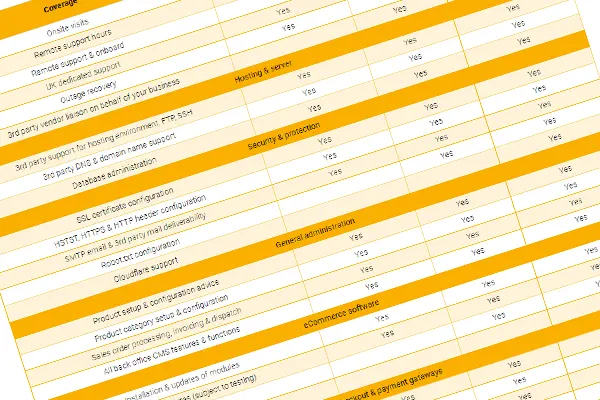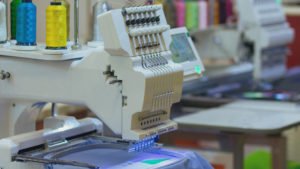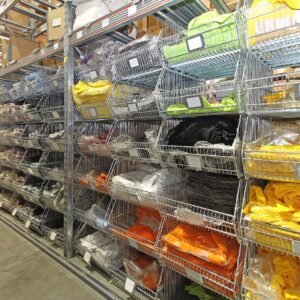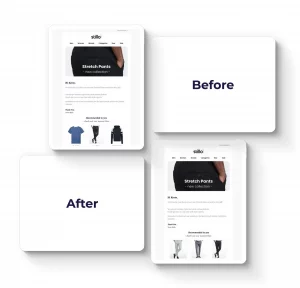Emma Taylor-Lane
28 October 2022
eCommerce
Emma Taylor-Lane
28 October 2022
The personalisation market in the UK is worth over £1 billion per annum. And more and more people and businesses are shopping online, taking advantage of the convenience of being able to shop at a time and place that suits them.
If you’re in the garment personalisation industry, then you’re probably receiving more sales online than ever before. Are your systems coping with the additional sales? Or is it time to review your procedures and processes? Then it may be time to consider an ERP system.
ERP, or Enterprise Resource Planning software and systems can be used to connect all aspects of a business’ processes, from ordering to manufacturing, to procurement, to despatch, to accounts. Used correctly, it provides a complete overview of the business on a minute-to-minute basis.
Having a centralised ERP is essential for any growing eCommerce business, especially in the personalisation industry, where there’s a high turnover of individualised products. Whether you use a Tajima embroidery sewing machine, or a Ricoma, an ERP system will smooth out any bumps in the process
Do you know your exact stock situation at this moment in time? Do you know if you can fulfil that order that just came in? Or will your customer have to wait for you to restock? If you don’t know, you need an ERP system.
And how do you manage your manufacturing processes? Are they still processed manually? How efficient are your methods? Are your staff struggling to locate inventory, or spending time uploading orders by hand? An ERP system combined with digital embroidery software, such as Wilcom, streamlines the whole process, digitising both input and output.
If you’re using legacy systems, chances are that you don’t have a full overview of your business. You’re probably using various, siloed systems where information has to be transferred manually from one to another. This allows room for human error as well as obscuring data. If you want up-to-date, minute by minute information, ERP and eCommerce process automation is the way forward. Let’s look at why.

While the personalised garment market is growing, so is competition. You need to be agile, reactive, and efficient. Existing software and systems may no longer be adequate for your business’ needs.
An ERP system simplifies the entire ordering process. You’ll always know what stock you have in hand. The manufacturing process is also streamlined, decreasing the time taken to produce orders and reducing the risk of human error. This frees up your employees’ time enabling you to increase capacity and, therefore, profits.
Businesses rely on information to be competitive. Data is key to managing customers, spotting trends, and making effective business decisions. Integrating your ERP system with your website, accounts packages and other software allows for realtime data to be available throughout the organisation as it’s needed.
Automation is a key benefit of an effective, well-integrated ERP system. Unified processes from order, to manufacturing and dispatch, and even accounts, allows you to scale up your business through increased efficiency.
Customer service has never been more important. Happy customers mean customers who return, and who recommend your business to others. ERP systems help support your customer service through providing ease of purchasing through a number of channels; through providing data that helps you keep the customer updated on their order’s progress; and through helping you anticipate customer needs and wants.

Of course, implementing new systems comes with challenges. So, what do you need to think about when integrating an ERP system into your garment personalisation business?
It’s not unusual for ERP implementations to go over budget, usually because of system modifications to improve usability and personalise it to the individual organisation’s needs. However, the right ERP partners will work closely with you from the very start of the process to anticipate your needs and help mitigate unexpected costs.
And an ERP system should be considered an investment in your business that will generate ROI including reduced costs, reduced inventory levels and reduced cycle time.
Any new system implementation can fail, and ERPs are no different. But there are actions you can take to reduce the chances. Planning ahead, communication, and staff buy-in are all key to a successful implementation.
It’s common for businesses to have to overcome internal resistance to new ways of doing things. Ensuring that employees understand the benefits of the new system and providing adequate training will help them to accept change.

There are a range of ERP integrations available, and the ones you choose will very much depend on your IT resources and your individual business needs.
eCommerce integration is probably the most popular integration. It involves connecting your existing eCommerce system, such as Shopify, with your cloud-based ERP. In conjunction with one another, they expand your website’s functionality and, best of all, create a better shopping experience for your customer, resulting in happier customers and fewer abandoned baskets.
The advantages of connecting your ERP system to your eCommerce site is that extensive data such as leads, customers, orders, shipping times, taxes and customer support can all be easily tracked by anyone in the organisation who needs that information.
Managing customer relationships is vital for making the most informed business decisions. CRM systems manage data such as purchases and contact information. It’s used to gain better insights into customer behaviour which allows for better decision making.
Business intelligence software allows authorised users to retrieve, analyse, and report data. This is especially important for organisations going through a digital transformation, as it provides up-to-date information in realtime. This enables stakeholders to discover new insights, which can help improve profits.
If you’re having to manually input orders into your accounting system, there’s room for human error. Many ERP systems integrate with world-leading accounts packages, such as Sage and Xero and so automate this process. This makes invoicing and reconciliation much faster and simpler.

While ‘integration’ has a number of meanings in eCommerce, it effectively means that two systems with strong application program interfaces (API) should be able to talk to each other, known as integration. Sometimes these connections are known by other names; for example, Shopify calls them apps.
A newer – and increasingly popular – integration strategy is known as ‘integration platform as a service (iPaaS)’. This is a cloud-based approach that enables APIs to sync more quickly and easily. It requires no coding and connects ERP systems to Software as a Service (SaaS) systems.
While much of the work is already completed, some tweaking may be needed by a developer or your integration partner to ensure it works as well as possible. While it’s often possible to install integration yourself, it’s always better to get a professional involved.
Shopify, one of the most popular eCommerce installations, integrates with both DecoNetwork and Wilcom, ERP systems designed specifically for the garment personalisation markets.

When integrating a new ERP system, best practice dictates that you take a number of steps to ensure a successful implementation.
Fail to plan, plan to fail, as the saying goes. Before integrating an ERP, create a plan with your team. Someone who understands both the company’s internal processes and the business goals. They should work closely with departments through the organisation to plan for any obstacles that might arise.
It’s best to focus on the most common use cases, but don’t ignore less frequent events, so that you can be sure that your integration meets your needs.
When creating your implementation plan, you should consider:
It’s not unusual for teams and partners to push back when change happens. They’re familiar with the old ways of doing things and may not see the need for them to change. It may be that adaptations to processes and routines are necessary, even if you’re currently using newer, cloud-based ERP systems, such as DecoNetwork.
Communication is key. And not just with management. Warehouse and logistics staff need to understand how the way orders arrive may change, how processes may change, and how fulfilment may change. They should be involved from the earliest opportunity so that their feedback can be heard and integrated into planning.
Data is key to any organisation’s success. Clean, reliable data enables you to understand your business processes, and has a positive effect on your bottom line. It’s important to regularly cleanse and validate data and review who has access to data and why.
It’s best to start these processes before ERP integration takes place. This way, delays are reduced and the transition to the new system will be smoother.
DecoNetwork is designed for the personalised garment market and integrates with Wilcom, the digitisation software. DecoNetwork integrates with other software packages, such as Shopify, WooCommerce and world-leading accounts packages.
Tracker, our preferred ERP package, was designed specifically for the personalisation industry by someone with extensive experience in this market. It features six basic modules, which encompass everything from orders, products and inventory to CRM, supplier management and simplified procurement. Additional options include eCommerce integrations with your website and accounts.
Find out more about eCommerce embroidery automation and how it can help your business here.
So, if you’re considering upgrading your existing legacy systems, why not get in touch with Demystify Digital today? We offer a FREE one-hour consultation with no obligation. Email us at [email protected] or call us on 01903 372 402.
Think or can help or need to talk? Book an online Teams meeting today or call 01903 372 402
Contact us details can be found below. If you fancy a chat, please feel free to call.
Demystify Digital Limited is a limited company registered in England and Wales. Registered number: 13844077.
© 2022 Demystify Digital Limited. All rights reserved
| Cookie | Duration | Description |
|---|---|---|
| cookielawinfo-checkbox-analytics | 11 months | This cookie is set by GDPR Cookie Consent plugin. The cookie is used to store the user consent for the cookies in the category "Analytics". |
| cookielawinfo-checkbox-functional | 11 months | The cookie is set by GDPR cookie consent to record the user consent for the cookies in the category "Functional". |
| cookielawinfo-checkbox-necessary | 11 months | This cookie is set by GDPR Cookie Consent plugin. The cookies is used to store the user consent for the cookies in the category "Necessary". |
| cookielawinfo-checkbox-others | 11 months | This cookie is set by GDPR Cookie Consent plugin. The cookie is used to store the user consent for the cookies in the category "Other. |
| cookielawinfo-checkbox-performance | 11 months | This cookie is set by GDPR Cookie Consent plugin. The cookie is used to store the user consent for the cookies in the category "Performance". |
| viewed_cookie_policy | 11 months | The cookie is set by the GDPR Cookie Consent plugin and is used to store whether or not user has consented to the use of cookies. It does not store any personal data. |